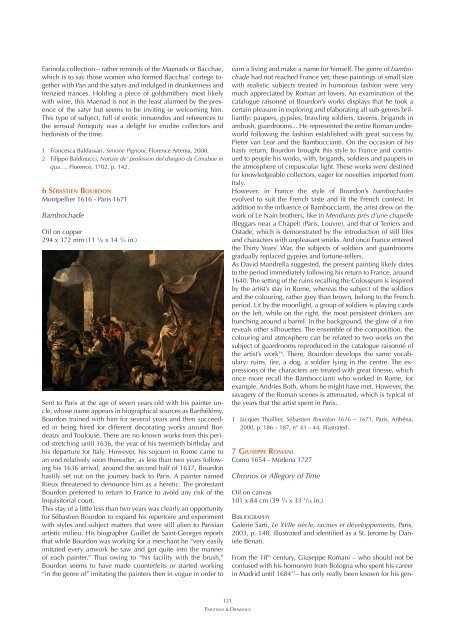Create successful ePaper yourself
Turn your PDF publications into a flip-book with our unique Google optimized e-Paper software.
Farinola collection – rather reminds of the Maenads or Bacchae,<br />
which is to say those women who formed Bacchus’ cortege together<br />
with Pan <strong>and</strong> the satyrs <strong>and</strong> indulged in drunkenness <strong>and</strong><br />
frenzied trances. Holding a piece of goldsmithery most likely<br />
with wine, this Maenad is not in the least alarmed by the presence<br />
of the satyr but seems to be inviting or welcoming him.<br />
This type of subject, full of erotic innuendos <strong>and</strong> references to<br />
the sensual Antiquity was a <strong>de</strong>light for erudite collectors <strong>and</strong><br />
hedonists of the time.<br />
1 Francesca Baldassari, Simone Pignoni, Florence Artema, 2008.<br />
2 Filippo Baldinucci, Notizie <strong>de</strong>’ professori <strong>de</strong>l disegno da Cimabue in<br />
qua…, Florence, 1702, p. 142.<br />
6 SÉBASTIEN BOURDON<br />
Montpellier 1616 - Paris 1671<br />
Bambocha<strong>de</strong><br />
Oil on copper<br />
294 x 372 mm (11 5 /8 x 14 3 /4 in.)<br />
Sent to Paris at the age of seven years old with his painter uncle,<br />
whose name appears in biographical sources as Barthélémy,<br />
Bourdon trained with him for several years <strong>and</strong> then succee<strong>de</strong>d<br />
in being hired for different <strong>de</strong>corating works around Bor<strong>de</strong>aux<br />
<strong>and</strong> Toulouse. There are no known works from this period<br />
stretching until 1636, the year of his twentieth birthday <strong>and</strong><br />
his <strong>de</strong>parture for Italy. However, his sojourn in Rome came to<br />
an end relatively soon thereafter, as less than two years following<br />
his 1636 arrival, around the second half of 1637, Bourdon<br />
hastily set out on the journey back to Paris. A painter named<br />
Rieux threatened to <strong>de</strong>nounce him as a heretic. The protestant<br />
Bourdon preferred to return to France to avoid any risk of the<br />
Inquisitorial court.<br />
This stay of a little less than two years was clearly an opportunity<br />
for Sébastien Bourdon to exp<strong>and</strong> his repertoire <strong>and</strong> experiment<br />
with styles <strong>and</strong> subject matters that were still alien to Parisian<br />
artistic milieu. His biographer Guillet <strong>de</strong> Saint-Georges reports<br />
that while Bourdon was working for a merchant he “very easily<br />
imitated every artwork he saw <strong>and</strong> got quite into the manner<br />
of each painter.” Thus owing to “his facility with the brush,”<br />
Bourdon seems to have ma<strong>de</strong> counterfeits or started working<br />
“in the genre of” imitating the painters then in vogue in or<strong>de</strong>r to<br />
earn a living <strong>and</strong> make a name for himself. The genre of bambocha<strong>de</strong><br />
had not reached France yet; these paintings of small size<br />
with realistic subjects treated in humorous fashion were very<br />
much appreciated by Roman art lovers. An examination of the<br />
catalogue raisonné of Bourdon’s works displays that he took a<br />
certain pleasure in exploring <strong>and</strong> elaborating all sub-genres brilliantly:<br />
paupers, gypsies, brawling soldiers, taverns, brig<strong>and</strong>s in<br />
ambush, guardrooms... He represented the entire Roman un<strong>de</strong>rworld<br />
following the fashion established with great success by<br />
Pieter van Lear <strong>and</strong> the Bamboccianti. On the occasion of his<br />
hasty return, Bourdon brought this style to France <strong>and</strong> continued<br />
to people his works, with, brig<strong>and</strong>s, soldiers <strong>and</strong> paupers in<br />
the atmosphere of crepuscular light. These works were <strong>de</strong>stined<br />
for knowledgeable collectors, eager for novelties imported from<br />
Italy.<br />
However, in France the style of Bourdon’s bambocha<strong>de</strong>s<br />
evolved to suit the French taste <strong>and</strong> fit the French context. In<br />
addition to the influence of Bamboccianti, the artist drew on the<br />
work of Le Nain brothers, like in Mendiants près d’une chapelle<br />
(Beggars near a Chapel) (Paris, Louvre), <strong>and</strong> that of Teniers <strong>and</strong><br />
Osta<strong>de</strong>, which is <strong>de</strong>monstrated by the introduction of still lifes<br />
<strong>and</strong> characters with unpleasant smirks. And once France entered<br />
the Thirty Years’ War, the subjects of soldiers <strong>and</strong> guardrooms<br />
gradually replaced gypsies <strong>and</strong> fortune-tellers.<br />
As David M<strong>and</strong>rella suggested, the present painting likely dates<br />
to the period immediately following his return to France, around<br />
1640. The setting of the ruins recalling the Colosseum is inspired<br />
by the artist’s stay in Rome, whereas the subject of the soldiers<br />
<strong>and</strong> the colouring, rather grey than brown, belong to the French<br />
period. Lit by the moonlight, a group of soldiers is playing cards<br />
on the left, while on the right, the most persistent drinkers are<br />
bunching around a barrel. In the background, the glow of a fire<br />
reveals other silhouettes. The ensemble of the composition, the<br />
colouring <strong>and</strong> atmosphere can be related to two works on the<br />
subject of guardrooms reproduced in the catalogue raisonné of<br />
the artist’s work 16 . There, Bourdon <strong>de</strong>velops the same vocabulary:<br />
ruins, fire, a dog, a soldier lying in the centre. The expressions<br />
of the characters are treated with great finesse, which<br />
once more recall the Bamboccianti who worked in Rome, for<br />
example, Andries Both, whom he might have met. However, the<br />
savagery of the Roman scenes is attenuated, which is typical of<br />
the years that the artist spent in Paris.<br />
1 Jacques Thuillier, Sébastien Bourdon 1616 – 1671, Paris, Arthéna,<br />
2000, p. 186 – 187, n° 43 – 44, illustrated.<br />
7 GIUSEPPE ROMANI<br />
Como 1654 - Mo<strong>de</strong>na 1727<br />
Chronos or Allegory of Time<br />
Oil on canvas<br />
101 x 84 cm (39 3 /4 x 33 1 /16 in.)<br />
BIBLIOGRAPHY<br />
Galerie Sarti, Le XVIIe siècle, racines et développements, Paris,<br />
2003, p. 148, illustrated <strong>and</strong> i<strong>de</strong>ntified as a St. Jerome by Daniele<br />
Benati.<br />
From the 18 th century, Giuseppe Romani – who should not be<br />
confused with his homonym from Bologna who spent his career<br />
in Madrid until 1684 17 – has only really been known for his gen-<br />
121<br />
PAINTINGS & DRAWINGS
















